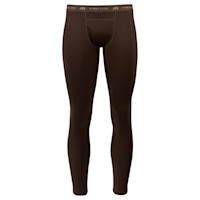
A well fit pack should evenly disperse the weight of the load through the torso, with most of the weight falling on the centers of your shoulders and your hips. Carrying a burly load is never an exercise in comfort, but a well fit pack can really make a difference and reduce the level of hell that you’ll certainly go through.
When choosing your backpack, it’s important to test the pack with weight in it. Start with around 40 pounds. The best choice for this weight would be actual hunting and camping gear, an otherwise empty pack with a 40 lb dumbbell won’t sit the same as a full pack, giving you a false fit.
Quick Guide for Pack Fitting
First, loosen all the adjustable load-bearing straps.
Find your hip crest, it’s the little nub that sticks out above your pelvis. Now center the hip belt on your hip nub. Buckle the belt and tighten firmly.
Tighten your shoulder straps until they are snug and obviously bearing some weight. If there is space between your shoulders and the straps then your pack is too long for your torso. Either shorten it if it is adjustable or try the next-sized pack.
Finally, find the load-lifter straps that should be hanging between your shoulders and the top of the pack. Crank down on these until you find a natural balance point and the load feels evenly dispersed.
Tips for Pack Fitting
There are a few tricks that will help you suffer less on the trail. For starters, keep the densest, heaviest gear centered in the lower third of your pack where it’s close to your lumbar spine. Think of things such as your tent, water jugs, sacks of food, or game bags full of meat following a successful hunt.
Once these things are loaded in the lower center of the pack, they can be wedged into place with clothes, smaller gear items, or a sleeping bag. Keeping things centered is crucial; if your balance is off to one side you’ll have a fair chance of pulling a back muscle, injuring a hip joint, or damaging your knees.
The rest of the pack should be organized according to your needs. Definitely consider where to put the things you may need at a moment’s notice. Your rain jacket should be accessible, as should a quart of water, sunglasses, multi-tool, GPS, etc. Game bags, extra socks, and other non-essentials can be tucked into corners where they won’t be getting in your way. Every backpack hunter has their own evolving sets of needs; experimentation will help you find a packing strategy that works best for your own style of camping and hunting.
A Few Extra Tips for Extra-Big Loads
There are two good ways to get a heavy pack up on your back. You can sit down, strap the pack on, and use your hands and knees to push up to standing. Or you can hold the two straps and lift the pack until the bottom rests on your bent knee, then quickly slide one arm through and swing the load onto your back.
Be very smart about how you move with this much weight on your back. Knees and ankles are incredibly vulnerable, especially when moving downhill. Your body will automatically move a little slower and more deliberately. Don’t fight that. Carrying a big load out is something to take your time with.
Smile at your task. Try to enjoy the discomfort. Rather than thinking about the end of the hike, try pretending that there is no end. This is your life now, walking and suffering. Find a way to get cozy with that new reality.
Use hiking poles. They reduce stress on your joints by 30% and give you extra stability to prevent blown out knees and ankles.







